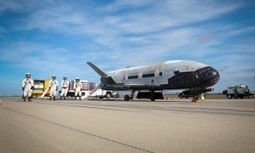X-37B craft launched from Cape Canaveral on Wednesday, its fourth long orbital flight in five years – but many details of the trip are being kept secret
A mysterious robotic space plane launched its secretive mission for the US air force on Wednesday, its fourth long orbital flight in five years.
The X-37B launched from Cape Canaveral, Florida, for the reusable spacecraft’s fourth mission. Its third mission lasted a record-breaking 675 days in space, and ended when it landed at an air force base in California in October 2014.
The spacecraft’s mission, including the technology on board and what its objectives are, are secret, but the air force has revealed at least one detail. In a statement, the air force said the X-37B will test a new electric engine called a Hall thruster, described as an “electric propulsion device that produces thrust by ionizing and accelerating a noble gas, usually xenon”.
Major General Tom Masiello, the commander of the air force research laboratory, space and missile systems center, said the X-37B mission would test a wide range of technologies. The higher-powered electric thruster could improve the efficiency of those technologies.
“Secure comms, [intelligence, surveillance and reconnaissance], missile warning, weather prediction, precision navigation and timing all rely on [space science], and the domain is increasingly contested,” Masiello said in a statement. “Less fuel burn lowers the cost to get up there, plus it enhances spacecraft operational flexibility, survivability and longevity.”
Captain Christopher Hoyler, an air force spokesman, said that the vehicle’s mission “cannot be specified” but that it will enhance “the development of the concept of operations for reusable space vehicles”.
In a statement, the director of the air force rapid capabilities office, Randy Walden, said: “With the demonstrated success of the first three missions, we’re able to shift our focus from initial checkouts of the vehicle to testing of experimental payloads.”
The Pentagon has consistently denied over the years that X-37B missions test space weapon capabilities.
Built by Boeing’s Phantom Works division, the spacecraft resembles Nasa’s classic space shuttle design in miniature; it is a fourth of the size of the original shuttles, at about 9.5ft tall and 29ft long, and is operated robotically. It runs partially on solar power, and probably tests a wide range of avionics, advanced spacecraft design technology and experimental spy sensors.
Nasa has also joined the X-37B experiment, sending dozens of material samples, including thermal coatings, ink and window substitutes, up in the shuttle’s payload. The Nasa experiment will test how those materials withstand the hazards of space, such as radiation and extreme temperatures. The original X-37A shuttle was of Nasa’s design, but the program was cancelled in 2006, at which point the air force and the military technologists at Defense Advanced Research Projects Agency (Darpa) adopted the program.
Also launched into space are 10 small satellites called CubeSats, including one known as the LightSail, developed by the nonprofit Planetary Society. The tiny satellite will unfurl four solar-powered Mylar sails after a month in space, for a first short test of solar sailing near Earth. Other CubeSats will perform propulsion and communication experiments for the US Naval Academy, California Polytechnic State University and the Aerospace Industries Association.



 Your new post is loading...
Your new post is loading...







